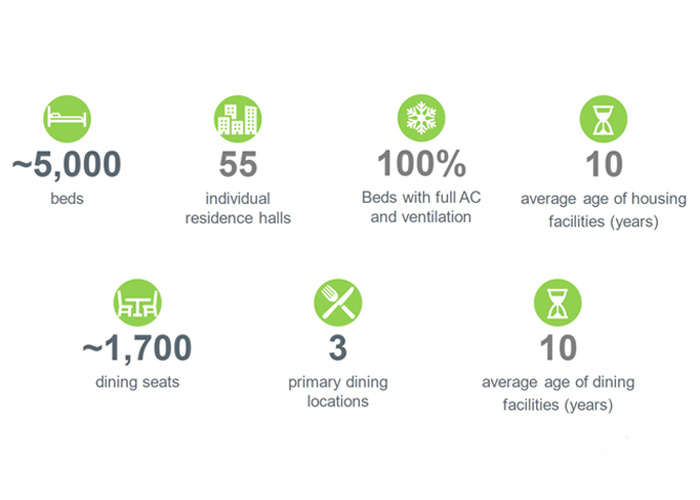William & Mary unveiled a long-term comprehensive plan Thursday to modernize and revitalize its residential and dining facilities. The 10-year project is part of a comprehensive strategy to address aging housing and dining facilities and ensure they advance the integration of living and learning on campus.
“A welcoming residential experience for students is essential to a William & Mary education,” said President Katherine A. Rowe. “Consistent with Vision 2026’s goal of ‘Evolving to Excel,’ we will shift from planning to implementation this spring. We aim to ensure that university housing and dining facilities will enhance William & Mary’s academic mission for generations to come.”
The plan, which aligns with the university’s sustainability goals, will be completed in three phases, Vice President for Student Affairs Ginger Ambler and Chief Operating Officer Amy Sebring shared with the Board of Visitors.
In addition to making upgrades across campus, the plan envisions a new entryway to campus on Jamestown Road that bridges Colonial Williamsburg, the City of Williamsburg and the campus. Once complete, the new and updated facilities will provide housing capacity equal to current levels, Ambler and Sebring said, adding the plan also will enable W&M to reach its goal of 100% climate controlled rooms within student housing.
Students who live in residence halls build stronger relationships with classmates, are more engaged with faculty and advisors, and are exposed to a wider range of ideas and cultures, according to national studies.
“Residential living contributes to student success, as well as to an enhanced sense of community at William & Mary,” Ambler said. “Our residence halls provide students with daily opportunities to engage with diverse people from around the world. Together, they practice democratic ideals through self-governance and they nurture friendships, many of which become lifelong. This facilities plan will ensure that we offer the best living-learning spaces possible for our students.”
Consistent with the broad objectives of the 2015 Campus Master Plan, the more recent planning has focused directly on how best to meet students’ needs while living and learning on campus.

The phased approach accounts for the smart enrollment growth plan already underway and provides predictable residential capacity even as the university takes housing facilities off line for renovations. As previously announced, William & Mary is phasing-in approximately 600 additional undergraduates to its four-year enrollment totals by the year 2025. In total, the facilities plan will overhaul 80% of the university’s housing inventory either by replacement or renovation, as well as providing two modern dining spaces.
William & Mary will use a multi-faceted approach to develop and fund different aspects of the plan through a combination of traditional university financing, leveraging its relationship with the William & Mary Real Estate Foundation and seeking public-private partnerships with third party developers.
“This plan is an essential component of the university’s broader vision for the future of the campus, including goals outlined in the Climate Action Roadmap,” Sebring said. “It is a long-term strategy that ensures the excellence our students experience in the classroom is matched with excellence in their living environments.”
Ambler and Sebring presented the plan at a joint meeting Thursday of the administration, buildings and grounds committee; committee on the student experience; and ad hoc committee on organizational sustainability & innovation as part of the university’s April Board of Visitors meeting. The board unanimously approved a resolution Friday supporting the plan. The resolution acknowledges the importance of the residential student experience at W&M, the advancement of the university’s environmental sustainability goals and the benefit of pursuing new funding alternatives to reduce cost.
Approval for Phase 1 of the project and updates to the Capital Improvement Plan are expected to come before the board for approval in September. Subsequent actions to approve funding arrangements, ground leases and related terms as needed would then be brought before the board for approval during the following year.
The plan’s three phases will be completed over 10 years:
Phase 1
Phase 1 includes renovation of Old Dominion and Monroe halls; construction of a new dorm to complete the planned Lemon and Hardy halls triangle; demolition of Yates Hall to build new campus housing referred to as West 1, construction of a new West Campus dining facility, demolition of Campus Center; and the replacement of the Green and Gold Village and the Commons Dining facility. The cost for Phase 1 is estimated at $234 million, leveraging W&M expertise for the renovation of Old Dominion and Monroe and using a public-private partnership for the construction of new facilities.
Phase 2
Phase 2 involves redevelopment of the current Campus Center site to include new construction of student housing, a dining facility, admission office and bookstore, as well as redeveloping the Randolph Complex site for a new dormitory facility; redeveloping the Richmond Hall site; new property development; upgrading One Tribe Place and demolition of the Botetourt Complex. The cost for Phase 2 is estimated at $350 million depending upon the programming, design and timing. A partnership with the W&M Real Estate Foundation will be used for the Campus Center site, Richmond Hall replacement and future property development with a public-private partnership planned for the West Campus housing site.
Phase 3
Phase 3 consists of developing student housing at a West Campus site to be determined, renovation of four residence halls — Barrett, Jefferson, Bryan, and the Sorority Complex, as well as renovating the Lettie Pate Whitehead Evans Graduate Complex and demolishing DuPont Hall. Costs for Phase 3 are anticipated between $100 million and $200 million using a public-private partnership for the new construction.
This story has been updated with Friday’s Board of Visitors action. –Ed.
Staff, University News & Media
